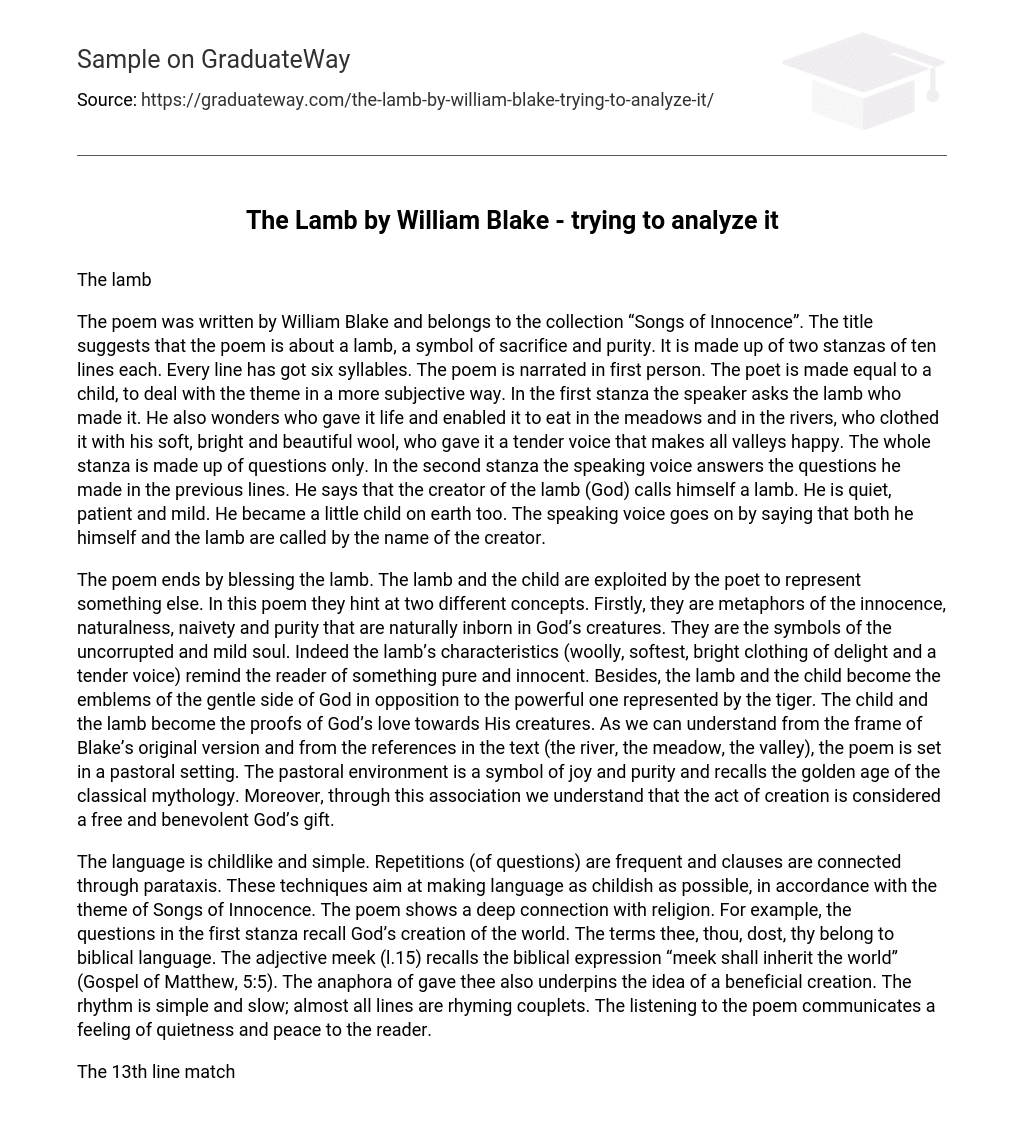The lamb
The poem was written by William Blake and belongs to the collection “Songs of Innocence”. The title suggests that the poem is about a lamb, a symbol of sacrifice and purity. It is made up of two stanzas of ten lines each. Every line has got six syllables. The poem is narrated in first person. The poet is made equal to a child, to deal with the theme in a more subjective way. In the first stanza the speaker asks the lamb who made it. He also wonders who gave it life and enabled it to eat in the meadows and in the rivers, who clothed it with his soft, bright and beautiful wool, who gave it a tender voice that makes all valleys happy. The whole stanza is made up of questions only. In the second stanza the speaking voice answers the questions he made in the previous lines. He says that the creator of the lamb (God) calls himself a lamb. He is quiet, patient and mild. He became a little child on earth too. The speaking voice goes on by saying that both he himself and the lamb are called by the name of the creator.
The poem ends by blessing the lamb. The lamb and the child are exploited by the poet to represent something else. In this poem they hint at two different concepts. Firstly, they are metaphors of the innocence, naturalness, naivety and purity that are naturally inborn in God’s creatures. They are the symbols of the uncorrupted and mild soul. Indeed the lamb’s characteristics (woolly, softest, bright clothing of delight and a tender voice) remind the reader of something pure and innocent. Besides, the lamb and the child become the emblems of the gentle side of God in opposition to the powerful one represented by the tiger. The child and the lamb become the proofs of God’s love towards His creatures. As we can understand from the frame of Blake’s original version and from the references in the text (the river, the meadow, the valley), the poem is set in a pastoral setting. The pastoral environment is a symbol of joy and purity and recalls the golden age of the classical mythology. Moreover, through this association we understand that the act of creation is considered a free and benevolent God’s gift.
The language is childlike and simple. Repetitions (of questions) are frequent and clauses are connected through parataxis. These techniques aim at making language as childish as possible, in accordance with the theme of Songs of Innocence. The poem shows a deep connection with religion. For example, the questions in the first stanza recall God’s creation of the world. The terms thee, thou, dost, thy belong to biblical language. The adjective meek (l.15) recalls the biblical expression “meek shall inherit the world” (Gospel of Matthew, 5:5). The anaphora of gave thee also underpins the idea of a beneficial creation. The rhythm is simple and slow; almost all lines are rhyming couplets. The listening to the poem communicates a feeling of quietness and peace to the reader.
The 13th line matches and mirrors the 18th, whose position is symmetrical. Actually, the two lines establish a connection between God, the poet/child and the lamb. From the analysis we can single out three main themes.
The first one is the praise of God and His creation. God’s kindness can be proven in the innocence and purity of young and uncorrupted souls. The second one is the predominance of imagination in God’s and children’s thoughts. Indeed, their vision of the world is free from conventions; they are able to see the”greater reality” behind material things. For example, the child is able to notice God’s perfection, greatness and kindness by watching at a lamb. According to Blake, all creatures are born innocent and mild because God modeled them into His own image. However, the society and its wickedness corrupt them in time. Therefore the poem may consist in an encouragement to return to the primal innocence and imagination. The last theme is the importance of a close contact with nature. This contact makes mankind happy and joyful.





